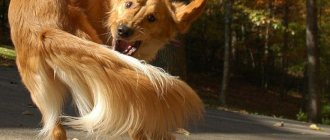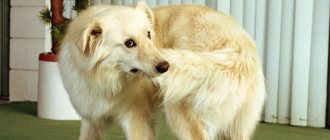Physiological features - why a tail is necessary
Humanity has always tried to impose its own vision of things on nature. There are no tailless dogs in nature, and the work of breeders has been frustrated more than once by this fact. From a scientific point of view, the tail is an important part of the spine. Responsible for the timely transmission of nerve impulses, regulates muscle balance and maintains normal cerebrospinal fluid pressure. Researchers, from their point of view, answered why dogs wave their tail. The reasons may be a desire to cheer yourself up, a signal of nervous tension, an attempt to relieve pain, itching, fear. Dogs born with a bent or shortened tail are considered physiologically inferior and should not be allowed to be bred.
From a physiological point of view, it is explained why dogs chase their tail. Unfortunately, this funny behavior almost always indicates trouble. There may be several reasons:
- Interesting - puppies exploring their bodies can run after the tail just like that.
- Behavioral syndrome - a pet deprived of attention is ready to bite its tail for the sake of praise / scolding of the owner.
- Nervous disorder - against the background of neural disorders, the dog may perceive its tail as an enemy. If a dog tries to catch up and bite the tail, “drives” it away from food, while behaving seriously and aggressively, this is a reason for close observation and a visit to the doctor.
- Kidney failure - if in combination with chases there is a deterioration in the condition, vomiting or diarrhea.
- Panic attacks – Pets that have experienced severe stress may spin around or chase their tail when they are nervous. With frequent relapses, the tailed friend needs support, attention and preventive examination by a veterinarian.
Why does a dog chase its tail?
Sometimes pet owners witness such a funny and at the same time mysterious phenomenon as a dog trying to catch up and grab its own tail. The reasons for such an action can lie in both behavioral and pathological spheres, therefore the context in which the dog begins to behave in a similar way is important.
The dog's attempts to grab its tail end in prolonged dizziness
Among the most common reasons why animals begin to chase their tail, we will focus on the main ones:
- showing interest in your body;
- need for attention from the owner;
- mental disorder;
- panic attacks;
- dysfunction of the vestibular apparatus;
- unsuccessful tail docking.
Showing interest in your body
This interest is most often found in puppies, who are generally distinguished by their curiosity. However, it is worth noting that normally this behavior has its own time frame. The baby quickly recognizes the tail as an integral part of his body and stops paying attention to it.
It is normal for puppies to show interest in their tail.
Need for attention
Through such unusual behavior, the animal sometimes sets itself the goal of attracting the attention of its owner (even regardless of whether the final reaction is positive or negative). In addition to the stereotypical tail chasing, a dog experiencing a lack of attention from its owner may exhibit other behavioral characteristics:
- hiding the owner's belongings;
- emptying the bowel or bladder in the wrong place;
- long and causeless barking.
Strange dog behavior may be a sign of boredom or a desire to be noticed by the owner.
Mental disorder
A mentally unstable dog may perceive the world around it and its body in a distorted way, recognizing the tail as a hostile living creature. Unlike puppy interest, this behavior is accompanied by pronounced aggression - the dog wants not only to catch up, but to bite and harm his “enemy.” If this symptom is detected, it is necessary to show the animal to a doctor.
Obsessively chasing its tail may indicate the presence of mental pathologies in a dog
Panic attacks
Unlike mental disorders, panic attacks may have nothing to do with disturbances in the central nervous system or other serious problems. Chasing the tail in such situations becomes a way to relieve stress and unnecessary tension that can be caused by any unpleasant events for the dog.
The following symptoms help recognize a panic attack:
- whining;
- increased salivation;
- random movement around the house;
- attempts to hide or run away from home;
- increased breathing.
Video - Panic attack in a dog
Vestibular syndrome
Circular movements, which normally cause dizziness, are forced for dogs that experience serious changes in the functioning of the vestibular apparatus. One possible cause of such changes is traumatic brain injury. In addition to injuries, poor coordination can also be caused by glycemia (which is especially typical for dogs with diabetes), as well as by certain pathologies in the liver.
In addition to chasing the tail, dogs with disorders of the vestibular system also experience coordination problems.
Failed tail docking
Unfortunately, not all operations of this type are carried out successfully and in some cases dogs are forced to get used to fragments of a severed vertebra, which cause discomfort to the animal. In addition to fragments, the surgeon may simply leave an insufficient amount of connective tissue, which will also lead to injuries and the dog’s attempts to lick its wounds.
An improperly docked tail will cause constant irritation to the dog.
Tail docking, a necessity or a “bad” habit?
In general, docking tails and ears is a precautionary measure and a way to protect the dog. As you know, dog fighting is prohibited and punished by law in all civilized countries, so docking for this purpose can be considered inappropriate. Some herding breeds that guard herds alone or in pairs run the risk of encountering wolves, so their ears and sometimes their tails are cropped for safety reasons.
The remaining “excuses” are nothing more than following breed standards. Of course, the standard is important, but animal rights activists have exerted positive pressure in this area as well. Almost all international kennel clubs condemn tail docking if it is not due to the pet’s lifestyle and “work”.
This is interesting! England, in recent times, became famous for its law on a tax on the length of a dog's tail. Fleeing from extortion, for many years the British docked the tails of their pets up to the second vertebra. This explains the standards of many breeds registered in the UK.
Tail docking
The docking procedure involves surgically removing part of a dog's tail. As a rule, this operation is performed on puppies, since they tolerate it most easily. The older the dog gets, the more difficult it is for her to cope with the absence of a tail and get used to a new way of life. The physiological side of the issue also has an effect - the wound after surgery in adults takes longer to heal than in cubs.
Tail docking using drag
Historical excursion
Tail docking for dogs is a very ancient practice, the first mentions of which go back to the times of Ancient Rome. During that era, docking was considered a preventative measure to protect dogs from rabies (as people believed at the time). Other reasons for tail removal in dogs in subsequent years were the following:
- safety of hunting dogs while chasing wild animals. It is logical that the dog’s long tail is easy to grab, thereby significantly reducing its chances of survival. No tail means no problem;
Hunting dogs had their tails removed to preserve the animal's life
- tax exemption. Several centuries ago, dog owners in England paid a tax for their dogs. Only hunting and service dogs (that is, dogs with docked tails) were not subject to this rule. However, it was also possible to evade the tax by a small trick - removing the tail of an individual that had nothing to do with hunting;
- the practice gradually turned into habit until it became a “canon” for a number of breeds, included in the standard and required of dogs participating in exhibitions.
For some dog breeds, tail docking is a requirement for participation in shows.
Our days
At the moment, docking is prohibited in a number of European countries. The exception is dogs that are involved in the following organizations:
- government law enforcement agencies;
- armed forces;
- rescue services;
- services responsible for removing rats and other rodents.
Tail docking before and after
That is, tail removal is permitted only in cases where it is due to the main occupation of the animal and serves to preserve its health. However, even such individuals must undergo a docking procedure according to strict rules:
- Only a qualified veterinarian can perform surgical intervention;
- docking should take place in the first five days of the calf's life.
Age restrictions
Despite the existence of the Animal Law, the points of which we discussed above, its requirements are not met in all countries. In this regard, docking continues to be practiced both in the first days after birth and after the dog reaches maturity. You can read about how tail docking occurs in puppies at different ages in the table.
Table 1. Tail docking in puppies of different ages
| Age | Features of the operation |
| Three to ten days | This age is optimal for the operation, since in newborn puppies the wounds heal quickly enough and are least painful. Due to the fact that the tail vertebrae have not had time to ossify, tail removal is not accompanied by sutures. The reduced pain threshold also allows you to do without the use of anesthesia. During the healing period, puppies are not allowed near their mother, as there is a possibility that she will begin to lick the wound, thereby lengthening the healing time and increasing the risk of infection. |
| Ten to twenty days | Starting from the age of ten days, the threshold of sensitivity in puppies rises, which leads to the need to use anesthesia, which affects the baby’s body. Otherwise, the operation is carried out in a similar way - the puppy’s tail is cut off without applying tourniquets, since the vertebra is still quite soft and heals quickly |
| From twenty days to a month | One-month-old puppies have their tail removed under general anesthesia, and the operation is performed with the obligatory application of a tourniquet to the base of the tail. Tail docking is the most difficult for older puppies, so veterinarians strongly advise against delaying this procedure. |
It is believed that puppies tolerate amputation the easiest
Cons of tail docking
A very natural question would be why animal rights activists are so actively in favor of banning tail docking on dogs. The fact is that while providing the animal’s safety in a number of cases, tail removal is still a gross intervention in the dog’s physiology, leading to a number of complications in the individual. Such complications include the following:
- weakening of motor skills;
- pathologies of urinary functions;
- the appearance of intervertebral hernias;
- deformation of the fingers of the hind limbs;
- problems in establishing relationships with other relatives;
- behavioral disorders (increased level of aggression).
Dogs with docked tails may later develop various motor and genitourinary complications.
Of course, one dog does not account for the entire list of possible violations given above. It also happens that individuals with docked tails live a long and prosperous life as a healthy dog. However, this scenario is not always realized, because tail docking can have a negative impact on both a physiological and psychological level.
Psychological aspect
As mentioned earlier, the tail is one of the dog's main means of communication. Therefore, a dog with a missing tail is in a certain isolation from its surrounding relatives. Other dogs are wary of the “stranger” because they cannot determine his mood and approximate plans.
Dogs that have not found a common language with their relatives can become depressed and need support.
Being social animals, dogs with docked tails have a hard time being an outcast. Largely for this reason, docking causes an increase in aggression in the animal. Therefore, a dog with a tail removed needs a caring and understanding owner who can compensate for the lack of full interaction with other dogs.
Tail as a communication tool
Studies of dogs' communication with other animals and people have explained why a dog wags its tail. For experienced breeders this is not a discovery, but for the scientific world it is a significant contribution. The first and most obvious function of the tail is to express emotions and mood. There is a whole “tail alphabet” that helps to accurately determine a dog’s emotions, for example:
- Wags its tail strongly at body level - I’m happy, I want to play, I’m bored, I can’t wait.
- Wags his tail low - I obey. If the tail is tense and held straight - Don't mess with me!
- The tail is straightened at the level of the spine, tense, swaying slightly - I can play or bite, but what do you say? If there is no swaying, and the hair on the withers stands up - Save yourself, I’m not joking anymore!
- The tail is raised high, tense, the tip is actively wagging - I am observing and ready to act; Am I in charge here or does someone want to argue?!
Tail as an odor blocker
In order to deepen the understanding of this important function, it is necessary to first explain such a physiological detail as the paraanal glands. Many owners do not even have an idea about these glands, since it is very difficult for someone inexperienced in zoology to recognize their influence on the dog’s life.
The paraanal glands require periodic care to avoid inflammation.
Externally, the paraanal glands resemble small sacs that are located at the exit from the anus of the animal. Over time, the bags are filled with a specific secretion, which is capable of emitting its own individual smell. This smell is an element of a complex system of interaction between dogs.
Functions of the paraanal glands
The paraanal glands acquire the greatest importance during the period of sexual readiness, since they perform the following two important functions:
- notify the hypothetical sexual partner that the individual is ready to mate;
- notify the animal’s rivals about its plans for a partner and its readiness to fight.
The anal glands are an important tool in canine communication.
The smell emanating from the secretion can either actively spread or be drowned out - it all depends on the dog’s intentions and mood. By actively waving its tail, the animal uses it as a fan, thanks to which the smell of the secretion spreads faster, thereby spreading information about the presence of the dog. If a dog does not want to be recognized and participate in any communication with its relatives, it deliberately presses its tail to hide its presence.
As a rule, acquaintance with the paraanal glands occurs when they become inflamed in a dog and require treatment. You can read below about how to avoid this painful phenomenon for your dog and learn how to flush these glands.
Cleaning the dog's anal glands
Purpose of a dog's tail
- A means of communicating with people.
With the help of their tail, dogs communicate with their owners, conveying their desires to them. A good, understanding owner knows that their pet's tail speaks volumes—its position changes depending on the dog's mood.
If you are just planning to get a dog or have not yet figured out how a dog communicates using its tail, study the following provisions and the meaning of these provisions:
- A raised and quickly wagging tail tells the owner about the dog’s cheerful mood and his joy from meeting him, as well as his desire to play.
- A lowered and quickly wagging tail tells the owner that the dog is ready to obey his commands.
- A wagging tail parallel to the back is an unusual condition of the dog, indicating the pet’s alertness and waiting for a response from the owner.
- A motionless tail parallel to the back and tousled hair on the withers indicate the dog’s aggressive attitude.
- A tense tail raised high and the tip of the tail wagging indicates the dog is ready to attack. This is a manifestation of aggressiveness.
- A high, stationary tail indicates that the dog is tense. Perhaps a meeting with a stranger or an unexpected sound.
- A tail tucked to the stomach indicates the dog’s fear or some kind of excitement.
- A relaxed tail lowered down indicates a calm, peaceful state of the dog.
As you can see, the position of a pet's tail can tell its owner a lot.
NOTE! If a dog wags its tail to the right, then it is happy, if to the left, then it is hostile.
- A way to maintain balance while running.
Dogs use their tail to keep themselves balanced. When a dog runs, it constantly swings its tail from side to side. Thus, the tail helps the dog maintain a stable position and successfully maneuver.
- Swimming assistance.
Dogs also need a tail when swimming in water. The tail helps the dog get tired less, thereby swimming long distances due to the fact that the load falls not only on the paws, but also on the tail. In addition, it helps dogs stay on the water.
- Heat retention.
A dog can use its tail to warm itself when it is cold. To do this, she curls up into a ball and covers her nose with her tail.
- A way to transmit information to other dogs.
A dog has special paraanal glands under its tail that contain a secretion that has an individual smell. With their help, dogs communicate with each other. This becomes especially important during puberty, when dogs use this scent to signal their readiness to mate.
It is with the help of the tail that these odors are controlled. When a dog wags its tail, it spreads a scent. If you want to remain unnoticed, the dog simply presses its tail and the smell is blocked.
- Sign of health
You can often see dogs running after their own tails.
This behavior can say a lot:
- This is usually done by puppies who have not yet understood what it is and think that it is their toy.
- If such behavior is detected in an adult dog, the owner should devote more time and attention to it, as this is a signal of their deficiency.
- Also, an adult dog running after its tail may indicate nervous disorders. If you notice that your dog is biting its tail, you should contact your veterinarian.
In addition, a dog may chase its tail if it has helminths or other diseases. This should be accompanied by diarrhea or vomiting. In this case, you need to show the animal to a veterinarian.
- An indicator of the beauty and purebred of a dog.
A dog without a tail is no longer a dog. A dog's tail gives it a special beauty. The description of each breed standard always includes a description of the tail. So, by examining the tail, you can find out about the purebred of the dog.
Some dog breeds require tail docking. Wikipedia reports that the tail is docked as early as possible so that the dog has not yet had time to get used to its presence, and also at an early age, while the cartilage is not yet strong, it is not so painful.
NOTE! They even wrote a poem about a dog's tail, and then recorded a song.
Why do dogs have their tails docked?
Docking is an operation during which the surgeon removes ⅔ of the tail. The procedure has been carried out since dogs were domesticated. The first reason they started doing this was safety.
In ancient Rome, gladiator dogs had their ears docked. This was due to a reduction in the area of the fighting dog’s body so that opponents could not grab onto the appendages.
The standard for some breeds is tail docking. However, this procedure will be justified if the dog is a hunting or fighting breed. For other pets, it is not recommended to seek the help of a surgeon.
Corgi with docked tail
Physiological features and types
Physiologically, the tail consists of several vertebrae, since it is a continuation of the spine. Depending on the breed of the animal, the shape and length of the appendage changes. Indicators vary depending on the area of origin of the animal, as well as its purpose. There are several types of appendages:
- The log is straight, elongated, round. The dogs got it from the wolf. It is currently found rarely and mainly in Labradors and St. Bernards.
- Saber-shaped - in a calm state, lowered and slightly curved, resembling a saber in appearance. The owners are German shepherds and collies.
- The hook is lowered in a calm state with a fairly strongly bent end. South Russian and Caucasian shepherd dogs have it.
- Crescent - curved over the back, but does not lie on it. Huskies and Spitz dogs are endowed with a similar feature.
- The ring is completely curved and lies on the back of the animal. Owners: Huskies, Malamutes, Siberian Huskies.
Interesting information! In some breeds, the tail may have two curls, a spiral shape and a corkscrew shape. Hunters have their own terminology for the names of types of appendages in dogs.
How to recognize tail signals
When anxious, fearful, or submissive, the dog begins to lower its appendage. When excited and aggressive, the pet raises its tail. Animals may wag at them when there is physical discomfort or in front of unfamiliar people. Depending on its condition, the following states are distinguished:
- quick wagging at the level of the back - joy;
- a dog's tail is like a rod - aggression;
- slightly moving lowered appendage – submission;
- straightened, located at the level of the back - vigilance;
- the dog moves the tip of the appendage located between the legs - uncertainty;
- wagging the tip of the tail held high - readiness;
- a calm appendage without movement - indifference;
- the appendage inserted between the hind legs means fear.
Note! You need to look not only at the tail to understand the mood of the dog. Facial expression and body tension are also important.
Why does a dog need a tail?
The caudal vertebrae are surrounded by many nerve endings. If you pull or pull a dog by the tail, then, in addition to acute pain, you can provoke problems with the coordination of the paws and the urinary system. For this reason, you should treat this organ with care and prevent it from being damaged.
The interaction of the brain and nerves clearly explains why a dog needs a tail. With its help, she can show her emotions by communicating with other animals and humans. The tail is also responsible for balancing the body, allowing you to maintain balance and direction in different situations.
Demonstration of mood
By the position and movement of a dog's tail, you can guess its mood. Once you become familiar with the basic positions, you will be able to better understand your pet.
Communication
By sniffing each other's tails, dogs remember the unique smells of new acquaintances - or identify their friends.
A special secret produced by the paraanal glands is responsible for the individual aroma. With its help, animals mark their territory and attract the opposite sex.
The high tail allows you to spread this smell around, scaring away potential rivals. If your pet finds himself in an unfamiliar place, then most likely he will try to hide his presence. In this case, its tail will be lowered.
Sense of space and balance
A dog's tail can be compared to a rudder or balance beam in the hands of trapeze artists. It helps you change direction while moving and maintain balance on shaky surfaces. While swimming, the tail takes on part of the load from the paws, so don’t be surprised if your four-legged pet beats you in a long-distance swim.
Research by scientists
To find out why dogs wag their tail, scientists from Italy conducted a series of studies. They studied the dependence of dog behavior on the functioning of the right and left hemispheres of the brain. After observing a group of 30 animals, they found that at the sight of a positive stimulus - the owner or a familiar dog, the animal rejoices, and at the same time expresses its emotions by wagging with a large bias towards the right side (the side of the left hemisphere). After all, it is the left hemisphere that is responsible for behavior and positive emotions.
When seeing a negative stimulus - a cat, an aggressive dog, a stranger, the tail deviated to the left side (the side of the right hemisphere) when wagging. It is known that the right hemisphere is responsible for actions related to survival.
Scientists have also found that dogs that receive these signals can recognize them. When meeting an unfamiliar dog, based on the direction of its tail waving, they draw a conclusion about what to expect from it. This is reflected in the cardioactivity readings and in the mood of the animals.
This asymmetry of body movements and body reactions is a reflection of the asymmetry of the left and right hemispheres, or, more precisely, the activation of one of them. The presence of this quality is evidence of the evolutionary advantage of the species, since it facilitates its survival in the surrounding world.
Difficult language of communication
The dog's tail is in a mobile state almost all the time. But active wagging does not always indicate a good mood and friendliness of its owner. There are several basic positions that reflect the emotions experienced by an animal at one time or another in its life:
- The natural calm position of the “mood indicator”, a slight waving, reflects calmness or friendly interest. It can be located in different ways. It depends on the breed. This is how dogs behave in the presence of their beloved owner.
- Intense waving combined with joyful barking and jumping speaks of jubilation and expresses joy at meeting after separation. The dog accompanies any long-awaited event with joyful, carefree wagging.
- A quick movement of the lowered tail, a bowed head - the pose of a guilty dog. At the same time, she may not realize why she is being scolded, especially if some time has already passed after the event.
- An elongated tail and slight trembling indicate alertness and anticipation. The dog is not entirely clear how events will develop.
- A tense, motionless tail, a fixed gaze, and tousled hair on the withers speak of aggression, anticipation of danger, and preparation for an attack.
- A tucked tail between the hind legs indicates fear, discomfort, reluctance to communicate, and recognition of one’s subordinate position in front of a stronger partner.
- A dog returning with prey holds its tail slightly above body level. This pose suggests that she is proud of herself and will not simply give up her prey.
Why do dogs wag their tail when they sleep? Sometimes a dog whines in its sleep, moves its paws, and moves its tail. This indicates that her emotional centers of the brain do not stop working. Animals, like people, dream. Their dreams arise in the stage of deep relaxation. Apparently, they consist of separate episodes in which the animals actively participate. A dog in a dream continues to be very sensitive. Eyes are slightly open, ears turn to every sound. Serving people does not stop for a minute.
Dog tail bone structure
The tail, or coccygeal region of a dog, is an extension of its spine, formed mainly by the caudal vertebrae and the distal bone. These are irregular bones that fit together. This region can vary greatly from race to race...
Can dogs feel their tail?
Many people wonder why cutting off a dog's ears or tail is bad. The truth is that dogs can sense their tails and will suffer pain to the point of injury. Additionally, not only is amputation a painful process, the post-operative period is also very uncomfortable for the animal and can cause infections, among other problems...
Dogs with docked tails
Tail docking is explained by safety, because its presence makes working dogs vulnerable. So, for example, when meeting a predator, a dog will have a better chance of remaining uninjured and emerging from the fight alive if the predator does not have the opportunity to grab the tail.
But appendages are also cropped for show dogs of certain breeds, for example Dobermans, Weimaraners, Spaniels, following the breed standard. However, the standards stipulate that docking must be determined by the lifestyle and activities of the animal.
Unfortunately, the presence of a short tail, and some dogs are deprived of it from birth due to breed characteristics, significantly reduces the ability to recognize and understand the emotional signals given by the animal. In addition, mutual understanding between animals is also difficult; for example, a playful and unintelligent puppy may not be able to interpret the signals given by a tailless animal, which may show reluctance to communicate with the puppy. As a result, the adult may bite or otherwise show aggression, making its intentions clear. Dogs approach tailless individuals with caution to avoid misunderstandings.
What does a dog “tell” us when it wags its tail?
Tail wagging is also a social indicator, which means: a dog will not wag its tail unless it is around other dogs or people . Even though "tail talk," as Dr. Buzhardt calls it, is a form of communication, dogs don't talk to themselves, so you won't see your furry friend wagging his tail if he's alone in the house.
“Puppies, when they are born, don’t know what it means to wag their tail any more than a newborn baby understands words,” explains the veterinarian. They usually start wagging their tail at 1 month, and since they are born in a litter, they learn how to do this from each other. Puppies learn that they can use their tail movements to communicate with their mother if they are hungry, or with their siblings if they want to play or are not socially inclined.
Why does a dog wag its tail and what does it mean?
A dog's tail is constantly in motion, and its wagging can convey completely opposite emotions. If the animal is in a good mood, then the movements of its tail are directed to the right, and if in a bad mood, to the left.
When communicating with each other, four-legged pets pay attention not only to the position, but also to the length of the appendage of their opponent. Long-tailed individuals receive the most respect. There is a possibility that this is due to easier interpretation of the signals given. But short-tailed dogs are often subject to aggressive attacks, so it is better not to let them go too far alone when walking.











